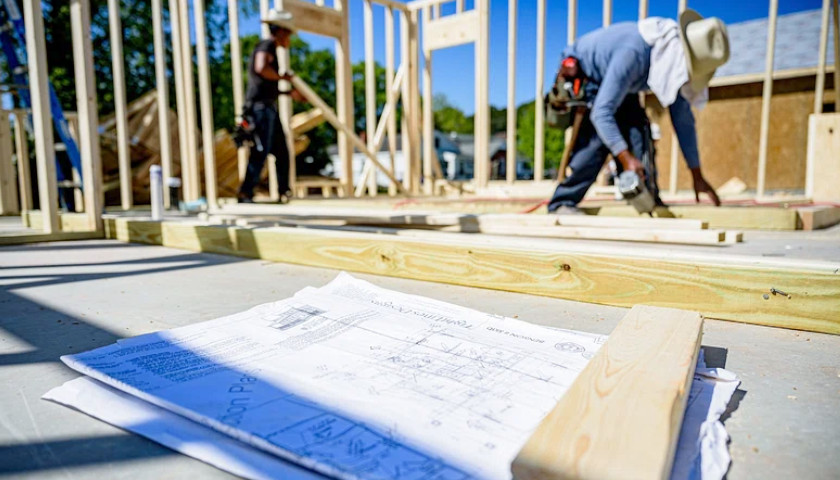Sen. Sherrod Brown (D-OH) claims to be a “champion of middle-class families” but his voting record to increase legal and illegal immigration which annually adds more working-age unskilled and low-skilled workers to compete with Americans, tells a much different story.
Brown’s legislative record reflects strong support for a globalist open-borders immigration system that protects illegal aliens, increased refugee resettlement and unvetted fraud in the asylum program. These entry pathways into the U.S. typically bring less educated, unskilled or low-skilled workers to compete with Ohio’s less skilled workers who are increasingly finding employment in Trump’s renewed economy.
In May, opening the Center for American Progress’ (CAP) “2018 Ideas Conference,” Brown was featured on a two-man panel discussing the “State of the American Economy” which he forecasted would be the central issue in upcoming elections. Brown challenged progressives to get on board with his version of how poorly “the little guy” is served economically by the Trump administration and asked simply, “are you on the side of Wall Street or are you fighting for the little guy?”
Not surprisingly, CAP, whose founder and former president John Podesta who also served as Hillary Clinton’s campaign manager, has benefitted from funding from George Soros’ Open Society Foundations/Open Society Institute. Reportedly, information leaked from an Open Society Foundation board meeting showed that between 2009 – 2014, CAP received $5.8 million dollars in Soros funding.
So it’s also not surprising that when Brown’s panel was introduced by CAP Board member Glenn Hutchins, he referred to CAP’s “shared values” of global prosperity and his characterization that today’s government is “hostile to middle class interests” noting specifically the “low labor force participation rate.”
A key factor related to both Hutchins’ distortion of the economy and Brown’s voting record on immigration, is the “notable improvement” in labor participation rate of the 25 – 54 year olds:
While on the surface this is great news for the US job market as many of those who until recently thought they would be unable to find a job, and had stopped being counted by the BLS, are once again back in the labor market, the flip side is that this sudden increase in new potential hires may keep wages suppressed longer than expected, as what until recently was observed as ‘lack of slack in the job market’ turns out to merely have been ‘workers on the sidelines.’
According to New American Economy’s Ohio-specific report The Contributions of New Americans in Ohio, 68% of all working-age immigrants in Ohio are in the all important 25 – 64 age bracket as compared to 52% of native born in the state. Within Ohio’s illegal alien population euphemistically referred to as “the undocumented,” 76% in this group “are more likely to be working-aged than natives or other immigrants.” It is this last group that NAE claims do not displace American workers because they do the jobs Americans won’t do.
New American Economy (NAE), the shortened name of the Partnership for a New American Economy, a powerful and well-funded big-business-cheap-labor lobby led by business leaders, former politicians, and chambers of commerce promotes its immigration agenda by highlighting the work ethic and perceived business ambitions of legal and illegal immigrants over native-born Americans.
Sherrod Brown’s voting record as tracked by immigration watchdog NumbersUSA, tracks the goals of the NAE which run rough-shod over “the little guy” that Brown believes he has long protected.
Last month, The New York Times offered up an encouraging picture for less educated low-skilled workers in Ohio who were previously shut out of the job market:
Until recently at Steel Ceilings in Johnstown, Ohio, the company’s president, Rick Sandor, insisted on a couple of years’ experience in metal fabrication before considering applicants. But he’s had a harder time lately finding workers for his company, where shifts run from 5 a.m. to 2 p.m. and temporary positions start at $14 per hour.
He now settles for candidates who show mechanical skills, like carpentry or heating and cooling repair. Mr. Sandor is willing to waive the requirement for a high school diploma as well and has even hired applicants with what he terms “minor” prison sentences.
“If a person was truly trying to get their life back together, we thought it would be helpful to offer them a job,” he said.
Brown’s immigration voting record for his entire Congressional career to date earned him a solid “F” grade and an even lower “F-” grade for the 2017 – 2018 legislative session from NumbersUSA. For example:
- in both 2017 and 2018, Brown voted to increase work visas including H-2B visas used to import foreign low-skill workers
- voted against the President’s Executive Order reducing the refugee admission cap
- voted to grant amnesty to illegal aliens
- voted for a bill sponsored by Sen. Churck Schumer that would have weakened border security and interior enforcement with regard to illegal aliens
- voted for two measures that would support sanctuary cities helping to protect illegal aliens that are arrested for committing local crimes
- voted for a bill that would have nullified the President’s Executive Order barring immigration from countries classified as “terrorist hotspots”
In 2015, Brown co-sponsored legislation to increase refugee resettlement numbers up to 100,000. According to the administration’s report to Congress for the FY19 proposed refugee admission ceiling, Ohio received 2,867 refugees in FY17, making it the fifth largest receiving state behind California, Texas, New York and Washington state.
As required by The Refugee Act of 1980, the report includes data from the U.S. Office of Refugee Resettlement 2016 Report to Congress and describes low levels of education of entering refugees, significant deficits in English language skills, employment rates and public benefits usage.
The most current data for this fiscal year which ends on September 30th, shows Ohio has resettled 1,301 refugees making it the second largest receiving state behind Texas. The number of refugees resettled in states that adjoin Ohio geographically were significantly less.
In 2017, Brown sponsored legislation to “overturn” the President’s Executive Order banning immigration from countries identified as “terrorist hotspots.” At the same time, Brown co-sponsored a resolution in support of refugees and asylum seekers.
The Trump administration has proposed a lowered 30,000 refugee admission ceiling for FY19, emphasizing the need to resolve the dramatic backlog of asylum petitions – 320,000 affirmative asylum cases, “the highest since 2002,” and the 348,000 asylum cases backed up in the immigration courts.
Additionally, the administration’s report raises the problem that ignoring the asylum petition backlog facilitates illegal aliens attempting to avoid deportation by applying for asylum:
Lengthy backlogs in asylum processing undermine the integrity of the asylum system. They delay legal protection for individuals who are legitimately fleeing persecution and have valid asylum claims. Further, such delays are a ‘pull factor’ for illegal immigration. By providing protection from removal, they create an incentive for those without lawful status to enter and remain in the United States. Asylum applicants also are eligible to obtain employment authorization after their asylum applications have been pending for six months, creating an incentive to file frivolous or fraudulent asylum applications.
Unlike refugees who enter the U.S. through the refugee resettlement program and are immediately able to work and apply for all forms of public assistance, people who apply for asylum enter the country illegally or alternatively, enter legally using a visa but request asylum when the visa expires.
Asylees whose petitions remain unadjudicated, generally are not able to access public assistance programs but may be granted a work permit if after 150 days no decision has been made on their asylum application. Once a petition is granted, however, an asylee is immediately eligible to work, obtain a social security card and apply for assistance through the U.S. Office of Refugee Resettlement. Approved asylees also become eligible to apply for all forms of public assistance.
The Trump administration intends to process asylum applications “last in, first out” so that disapproved applicants will be deported “well before six months have passed, which minimizes the incentive to file frivolous or fraudulent asylum applications to obtain work permission.
An April 2018 Ohio Department of Job and Family Services report indicates that employment opportunities for Ohioans with less than a high school diploma are expected to increase in the “advanced manufacturing industry cluster” which provides on-the-job training.
As reported in August 2018 by the Bureau of Labor Statistics, Ohio’s unemployment rate of 4.6% is “significantly different from” the national rate of 3.9 percent.
Using an index with factors including crime, economy, education, environment, health, housing, infrastructure and leisure, a group called 24/7 Wall St. ranked the 50 worst cities in which to live including five in Ohio. Cleveland was #5, Youngstown #15, Dayton #29, Canton #33 and Toledo #35.
Bureau of Labor Statistics July 2018 unemployment rates for the five cities are Cleveland 5.5%, Youngstown 6.1%, Dayton 4.7%, Canton 4.9% and Toledo 5.3% – all well above the national average.
– – –
Chris Alto is an investigative reporter at The Ohio Star.
Photo “Sherrod Brown with constituents” by facebook.com/sherrod





